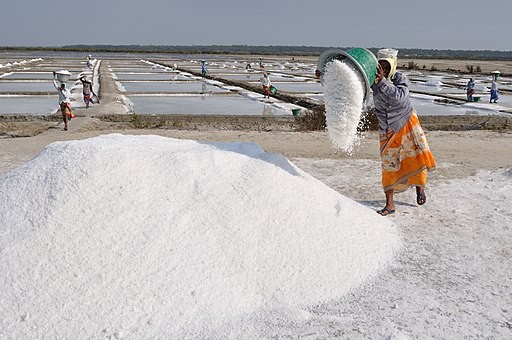The global demand for salt comes at a cost to both the environment and human health. Geological and hydrological processes naturally contribute to introducing salts into the environment over time. However, human activities significantly accelerate the operation of the natural salt cycle.

Natural Salt Cycle
Salt is present in nature, with salt accumulations commonly found along continental margins of former rifts. The salt cycle starts with the saturation of the newly formed oceanic crust with seawater, and the expansion gradually rises to the surface of the Earth from deep oceanic rocks.
Salt naturally emerges to the surface through geologic uplift and rock weathering. As rocks get broken down, they release salt ions into the soil. Plants and organisms take some up, while some are washed away into rivers and oceans. Salt also enters the atmosphere through sea spray in coastal areas and salt dust in dry regions.
This delicate balance has existed for millennia, and it is an important component of life on Earth since salt is needed in the bodies of humans, plants, and animals. However, getting too much of it may pose serious problems.
READ ALSO: Ocean Salinity: Seawater is Less Salty Today Than First 500 Million Years of Earth
Global Disruption
It has been found that the salt concentration in the environment is getting too high, and the soil and organisms cannot use all of it. This was revealed in a new scientific review by University of Maryland Geology Professor Sujay Kaushal.
Mining and land development rapidly accelerate the natural salt cycle. Salinization is also intensified by agriculture, construction, water and road treatment, and other industrial processes. These activities harm biodiversity and make drinking water unsafe in extreme cases.
These disturbances are called the "anthropogenic salt cycle" by Kaushal and his research co-authors. It establishes the impact of humans on the concentration and cycling of salt in a global, interconnected state.
Twenty years ago, the team conducted case studies that revealed the saltiness of surface waters in New York and the drinking water supply in Baltimore. In their recent study, they discovered that it is a cycle stemming from the deep Earth to the atmosphere, which human activities have perturbed.
In this research, the experts considered a variety of salt ions found underground and in surface water. Some of the most abundant salt ions are magnesium, calcium, potassium, and sulfate ions. Over the years, humans have disturbed other types of salts, like the ones related to calcium sulfate, gypsum, and limestone.
When these ions are dislodged in higher doses, they can cause serious environmental problems. As shown by the research team, salinization triggered by human activities has affected about 2.5 billion acres of soil around the world, an area about the size of the entire United States. Salt ions also increased in concentrations in streams and rivers over the last five decades, which coincides with an increase in the global use and production of salts.
This trend could be a permanent crisis if it remains unchecked. Experts predict that it is the direction that we are headed in since the global salt market is anticipated to grow by 43% in 2030. Kaushal hopes that their study will help raise awareness and prompt new policies.
RELATED ARTICLE: Road Salt Is Threatening North America's Freshwater Lakes
Check out more news and information on Salt in Science Times.














